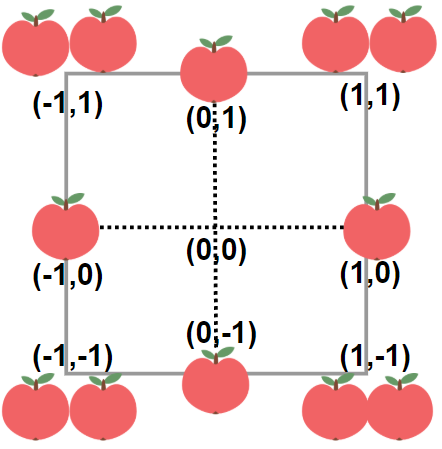LeetCode 1954. 收集足够苹果的最小花园周长:数学O(1)的做法
【LetMeFly】1954.收集足够苹果的最小花园周长:数学O(1)的做法
力扣题目链接:https://leetcode.cn/problems/minimum-garden-perimeter-to-collect-enough-apples/
给你一个用无限二维网格表示的花园,每一个?整数坐标处都有一棵苹果树。整数坐标?(i, j)?处的苹果树有 |i| + |j|?个苹果。
你将会买下正中心坐标是 (0, 0)?的一块 正方形土地?,且每条边都与两条坐标轴之一平行。
给你一个整数?neededApples?,请你返回土地的?最小周长?,使得?至少?有?neededApples?个苹果在土地?里面或者边缘上。
|x|?的值定义为:
- 如果?
x >= 0?,那么值为?x - 如果?
x <?0?,那么值为?-x
?
示例 1:

输入:neededApples = 1 输出:8 解释:边长长度为 1 的正方形不包含任何苹果。 但是边长为 2 的正方形包含 12 个苹果(如上图所示)。 周长为 2 * 4 = 8 。
示例 2:
输入:neededApples = 13 输出:16
示例 3:
输入:neededApples = 1000000000 输出:5040
?
提示:
1 <= neededApples <= 1015
方法一:求公式
边长为 2 n 2n 2n的正方形,苹果数量为多少呢?
由于X和Y是相互独立的,因此二者可以分开来看。对于X:
边长为 2 n 2n 2n的正方形一共有 2 n + 1 2n+1 2n+1行,每行有Y轴左右共 2 2 2部分。只考虑其中一行Y轴右侧的部分:
对苹果的总贡献数为 0 + 1 + 2 + ? + n = n ( n + 1 ) 2 0+1+2+\cdots+n=\frac{n(n+1)}{2} 0+1+2+?+n=2n(n+1)?
因此所有的X的贡献为 ( 2 n + 1 ) × 2 × n ( n + 1 ) 2 = n ( n + 1 ) ( 2 n + 1 ) (2n+1)\times2\times\frac{n(n+1)}{2}=n(n+1)(2n+1) (2n+1)×2×2n(n+1)?=n(n+1)(2n+1)
由于Y与X类似,所以Y的贡献与X相同,因此边长为2n的正方形的苹果数为 2 n ( n + 1 ) ( 2 n + 1 ) 2n(n+1)(2n+1) 2n(n+1)(2n+1)
n n n为多少才能至少有neededApples个苹果呢?
将上式处理一下: 2 n ( n + 1 ) ( 2 n + 1 ) = 4 n ( n + 1 ) ( n + 0.5 ) ≈ 4 n 3 2n(n+1)(2n+1)=4n(n+1)(n+0.5)\approx 4n^3 2n(n+1)(2n+1)=4n(n+1)(n+0.5)≈4n3并且大于 4 n 3 4n^3 4n3
也就是说要求的 n n n就在 1 4 n e e d e d A p p l e s 3 \sqrt[3]{\frac14neededApples} 341?neededApples?附近。令 m = 1 4 n e e d e d A p p l e s 3 m=\sqrt[3]{\frac14neededApples} m=341?neededApples?,其实从 ? m ? ? 10 \lfloor m\rfloor - 10 ?m??10到 ? m ? + 10 \lfloor m\rfloor+10 ?m?+10算一遍就直到答案了。
有没有更靠谱/可信一点的证明? (此部分可跳过)
令 n = ? m ? n=\lfloor m\rfloor n=?m?,令 f ( n ) = n ( n + 1 ) ( n + 0.5 ) f(n)=n(n+1)(n+0.5) f(n)=n(n+1)(n+0.5),则是在求最小的 n n n使得 f ( n ) ≥ 1 4 n e e d e d A p p l e s f(n)\geq \frac14neededApples f(n)≥41?neededApples。因为有:
- f ( n ? 1 ) = ( n ? 1 ) n ( n ? 0.5 ) < n 3 ≤ m 3 = 1 4 n e e d e d A p p l e s f(n-1)=(n-1)n(n-0.5)\lt n^3\leq m^3=\frac14neededApples f(n?1)=(n?1)n(n?0.5)<n3≤m3=41?neededApples,因此 n ? 1 n-1 n?1必定偏小
- f ( n + 1 ) = ( n + 1 ) ( n + 2 ) ( n + 1.5 ) > ( n + 1 ) 3 = ? m ? 3 > 1 4 n e e d e d A p p l e s f(n+1)=(n+1)(n+2)(n+1.5)\gt (n+1)^3=\lceil m\rceil^3\gt \frac14neededApples f(n+1)=(n+1)(n+2)(n+1.5)>(n+1)3=?m?3>41?neededApples,因此 n + 1 n+1 n+1必定满足要求
所以答案 a n s ans ans的范围是: [ n , n + 1 ] [n, n+1] [n,n+1],其中 n = ? m ? = ? 1 4 n e e d e d A p p l e s 3 ? n=\lfloor m\rfloor=\lfloor \sqrt[3]{\frac14neededApples}\rfloor n=?m?=?341?neededApples??。
因此只需要先计算出 ? 1 4 n e e d e d A p p l e s 3 ? \lfloor \sqrt[3]{\frac14neededApples}\rfloor ?341?neededApples??,并在不满足要求(苹果数偏少)时不断加加一,直到满足要求即可。(最多会加1次一)
- 时间复杂度 O ( 1 ) O(1) O(1),开立方根有内置库,可视为 O ( 1 ) O(1) O(1)时间复杂度
- 空间复杂度 O ( 1 ) O(1) O(1)
AC代码
C++
/*
x: 2(2n+1)(1+2+...+n)=n(n+1)(2n+1)
y = x
x + y: 2n(n+1)(2n+1) = 4n(n+1)(n+0.5)≈4n^3
*/
class Solution {
public:
long long minimumPerimeter(long long neededApples) {
long long ans = cbrt((double)0.25 * neededApples);
while (2 * ans * (ans + 1) * (2 * ans + 1) < neededApples) {
ans++;
}
return ans * 8;
}
};
Python
# from numpy import cbrt
class Solution:
def minimumPerimeter(self, neededApples: int) -> int:
ans = int(cbrt(0.25 * neededApples))
while 2 * ans * (ans + 1) * (2 * ans + 1) < neededApples:
ans += 1
return ans * 8
同步发文于CSDN,原创不易,转载经作者同意后请附上原文链接哦~
Tisfy:https://letmefly.blog.csdn.net/article/details/135183907
本文来自互联网用户投稿,该文观点仅代表作者本人,不代表本站立场。本站仅提供信息存储空间服务,不拥有所有权,不承担相关法律责任。 如若内容造成侵权/违法违规/事实不符,请联系我的编程经验分享网邮箱:chenni525@qq.com进行投诉反馈,一经查实,立即删除!
- Python教程
- 深入理解 MySQL 中的 HAVING 关键字和聚合函数
- Qt之QChar编码(1)
- MyBatis入门基础篇
- 用Python脚本实现FFmpeg批量转换
- JavaScript 本地存储
- Grind75第13天 | 208.实现Trie、54.螺旋矩阵、721.账户合并
- Thingsbaord采用redis缓存(自用)
- C# .Net学习笔记—— 异步和多线程(Task)
- lambda表达式 java & C++
- [NAND Flash 6.4] NAND FLASH基本读操作及原理_NAND FLASH Read Operation源码实现
- 第 381 场周赛 解题报告 | 珂学家 | 贪心构造 + 分类讨论&差分技巧
- MySQL增删改查(查询)
- Acwing861. 二分图的最大匹配(匈牙利算法)
- Vue中的加密方式(js-base64、crypto-js、jsencrypt、bcryptjs)